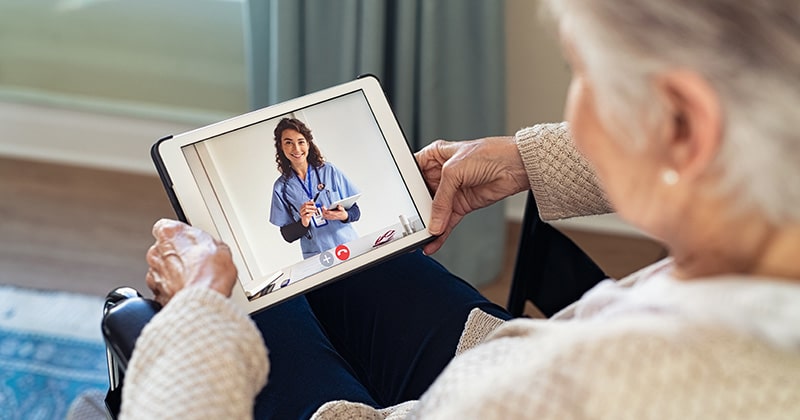Staying current and maintaining healthcare for patients with long-term illnesses is a continuous job. However, in recent years, telehealth has become a viable assistance option for managing chronic disease and improving patient outcomes.
Telehealth uses computers, smart devices, and voice calls to contribute to patient care remotely. It benefits patient care in various situations, but it’s especially well-suited to chronic disease management.
In this article, we’ll talk about how telehealth is a growing contributor to patient treatment plans and maintenance, especially for chronic disease management.
We’ll look at how it’s making a difference, the tools and services that play a vital role, the challenges faced, and what the future might hold.
We’ll also provide some additional practical advice on implementing telehealth as part of your practice.
Understanding Chronic Disease Management
According to the CDC, 60% of U.S. adults have at least one chronic disease, and about 40% have two or more. These conditions are leading causes of death and disability as well as major contributors to rising healthcare costs.
Chronic diseases clearly require a different management approach than acute conditions since the goal isn’t always to achieve full recovery. Long-term strategies aim to control symptoms, slow disease progression, and maintain or improve quality of life.
Historically, chronic disease management approaches have included monitoring, patient education, and lifestyle modifications. Patients with chronic disease can also benefit from integrated care, involving a team of specialists coordinating and addressing different aspects of treatment for a full spectrum of care.
Health professionals across disciplines collaborate, share information, and curate personalized treatment plans that consider patients’ physical, mental, and social needs.
Given their persistent nature, management of chronic diseases generally requires frequent interactions with healthcare providers. Simplifying and aggregating these interactions is where telehealth becomes indispensable.
The Rise of Telehealth
Telehealth—or virtual healthcare—is a modern way to deliver healthcare services using digital avenues like video calls, messaging through email or text, and voice calls.
At its simplest, it provides an equitable and appropriate alternative to in-person care that enhances patient health, lowers costs, and makes healthcare more accessible and flexible.
There are many advantages of using telehealth, both for the practice and the patient.
Benefits of Telehealth
A quick glance around in any public place will show that most adults own a smartphone. Telehealth uses that wide-reaching technology to put healthcare access straight into patients’ back pockets.
In this way, telehealth brings medical care to patients who might face challenges like transportation or mobility, including patients in remote locations.
Virtual visits allow more frequent and convenient conversations between patients and healthcare providers. Patients can communicate any changes in condition and receive timely adjustments to their treatment, while providers always have current data.
It’s easy to see how this increase in access and convenience would be useful for patients with chronic diseases, who may require regular monitoring but cannot accommodate multiple trips to the provider.
Some telehealth solutions, such as Updox, also integrate with most EHRs for thorough record-keeping and clinical data collection—critical for managing chronic diseases.
To augment telehealth, wearable medical devices, like blood pressure or glucose monitors, can send real-time health data to providers, leading to quicker treatment adjustments, better disease control, and fewer complications.
Telehealth benefits practices by reducing time and revenue loss due to no-shows. It can also reduce staff allocations to scheduling tasks, allowing them to dedicate their time to other aspects of the patient journey.
The Growth of Telehealth
The telemedicine market saw a valuation close to $115 billion in 2023. Experts predict this number will soar to $286.22 billion by 2030.
Within this booming sector, North America holds a 33.5% market share. In the U.S., demographic trends reveal interesting patterns.
Only 17.6% of Gen Z individuals use telemedicine services, making them the group that engages the least, while baby boomers lead the way, with a usage rate of 24.6%.
The COVID-19 pandemic influenced public opinion on telehealth. Now, 88% of Americans express a preference for telemedicine services.
Regarding the types of appointments most suited for telehealth, follow-up visits account for 47% of all telehealth interactions in 2023, highlighting the sector’s role in continuous patient care.
Impact of Telehealth on Chronic Disease Management
Frequent in-person visits are not always convenient due to work, family, and other responsibilities, which can lead to avoidance. In addition, those living in rural areas or with limited access to transportation may not have the means to travel to their healthcare provider’s office. Yet, we know maintenance visits are necessary for optimal chronic disease management.
Telehealth shifts the balance by allowing for more regular and flexible virtual visits while eliminating the need for travel. Patients can access the care they need to thrive from the comfort of their own homes.
The results can be incredible.
For example, Kaiser Permanente uses telehealth to achieve over 90% control rates for high blood pressure among its members—far higher than the national average.
This drastic difference is not due to better doctors or medications, but the regular monitoring and timely treatment enabled by telehealth.
FROM ONE OF OUR PARTNERS: What Are the Key Goals of Chronic Care Management?
Chronic Disease Management Through Telehealth
Telehealth is revolutionizing the management of chronic diseases by offering a new avenue for providing continuous and comprehensive care. Understanding and implementing telehealth services can enhance patient care and operational efficiency.
Let’s break down the approaches and benefits that help you achieve these outcomes.
Telehealth Interventions
Telehealth interventions simplify proactive disease management. You can:
- Use video consultations to discuss treatment plans.
- Try telehealth for specialist consultations. Patients can have access to the best care, unlimited by geographical constraints.
- Incorporate telehealth into your practice’s standard care protocols, ensuring a unified approach to disease management.
Remote Patient Monitoring
Remote patient monitoring (RPM) allows providers to track health data via in-home health devices like blood pressure, glucose, or fetal monitors.
RPM contributes to effective chronic disease management in a telehealth framework by allowing medical practices to:
- Continuously monitor vital signs and health metrics through connected devices, ensuring timely intervention when necessary.
- Reduce the need for in-person visits and hospitalization, optimizing practice workflow and resource allocation.
Remember to choose FDA-approved devices that will integrate with your electronic health records (EHRs) and telehealth platform. Easy integration improves data accuracy and accessibility.
Medicare, Medicaid, and many private insurers now provide coverage that supports RPM adoption.

Patient Engagement
Positive patient engagement is a benefit to any practice. Patients actively involved in their healthcare feel more empowered and develop better cooperative relationships with their providers.
Patients who understand their diagnosis and treatment often have better health results. They’re more likely to adhere to their treatment plans and make healthier choices. They may also realize issues earlier, which leads to better health management and fewer trips to the hospital.
Telehealth services can improve patient engagement by:
- Providing access to online resources and tutorials that patients can use at their convenience.
- Empowering patients with knowledge about their conditions, which helps reinforce the importance of compliance with their care plans.
- Presenting a platform for patient education. Providers can use telehealth visits to explain complex information in an accessible way.
RELATED ARTICLE: Maximizing Telehealth for Elderly Patients: Strategies and Best Practices for Engaging Senior Patients through Telehealth Platforms
Provider-To-Provider Collaboration
Provider-to-provider collaboration ensures a comprehensive and cohesive approach to patient care. Healthcare professionals from different specialties can share insights and coordinate treatment plans to better address complex health issues.
A collaborative effort enhances diagnostic accuracy and streamlines therapy. It also prevents the overlap of treatments.
As a result, patients benefit from a more integrated care experience.
Enhancing collaboration among healthcare providers is another advantage of telehealth because:
- It facilitates specialist consultations and multidisciplinary team meetings, combining diverse expertise to benefit patient care.
- Providers can use telementoring and telehealth conferences to keep teams informed and up to date.
- Platforms allow secure HIPAA-compliant communication among providers.
Telehealth Tools and Services for Chronic Disease Management
Telehealth is changing chronic disease management by bringing healthcare to patients’ fingertips.
Here are the tools and technologies you can use in your practice.
Mobile Health (mHealth) and Digital Health Apps
mHealth solutions are at the forefront of patient-engaged healthcare, empowering patients by offering real-time insights into their health status.
Secure SMS messaging, for example, allows providers to communicate with patients without spending extensive time on the phone or compromising patient privacy. It makes quick check-ins or questions much easier and more convenient for both parties.
Mobile-friendly patient portals allow patients to access their appointment schedules from anywhere at any time. Patients will feel more connected to their provider and that their time is respected.
Digital health apps can range from simple medication reminders to symptom trackers that allow patients to collect their own data.
Here’s how you can integrate these tools into your practice:
- Assist patients in setting up secure SMS messaging and show them the features of their patient portal to make them less intimidating tools.
- Educate them on how to share app data during consultations to enable more informed healthcare discussions
Wearable Devices and Remote Monitoring
Wearable health monitors and RPM devices deliver a continuous stream of health data, which can be helpful to chronic disease management via telehealth.
These types of remote technologies help reduce the need for in-person visits by accumulating long-term data while alerting providers to potential complications before they become a danger to patient health.
The following are some of the ways you can incorporate these technologies:
- Coach patients in the use of their wearable devices. Ensure they understand how they work, when and where they should be used, and how to care for them.
- Help with the setup and daily use of these devices. Patients should be comfortable and capable when tracking their health metrics.
Adopt RPM devices like heart rate monitors and pulse oximeters. Make sure they are FDA-approved. They should also integrate with your EHR system for optimal data utilization.
Telehealth Platforms and Virtual Consultations
Virtual consultations save time and make it easier for patients to get medical advice.
You can maximize the benefits of virtual care in chronic disease management by:
- Instructing patients on how to schedule and take part in virtual appointments.
- Investing in secure and reliable telehealth platforms. Examples include Updox, HealthTap, or Teladoc. Use these to conduct consultations.
FROM ONE OF OUR PARTNERS: Telehealth Vendors with Chronic Disease Management Services Most Attractive

What About Compliance?
Telehealth must follow HIPAA rules to keep patient information safe.
Healthcare providers must ensure they use a telehealth platform that guarantees HIPAA compliance. Not only do patients need to be assured that their health and personal information are secure, but providers also need to know that they won’t fall subject to legal action as a result of noncompliance.
Laws for telehealth, like who can offer it and where, can differ depending on the state where the practice is located. In some states, doctors can prescribe certain medications over telehealth if they meet special conditions.
Telehealth rules are continually updating. For example, Medicare has made it easier for patients to use telehealth by removing some old rules.
Now, Medicare patients can get telehealth services from home and can use just a phone for some appointments.
FROM ONE OF OUR PARTNERS: How Chronic Care Management Can Improve Your Bottom Line
Telehealth and Chronic Disease Management: Challenges and Looking Forward
The future of telehealth looks promising, with more advanced technology making healthcare accessible. It will likely become a regular part of how medical care is delivered.
However, it’s not without challenges. It is important to understand what those may be before you can implement a successful telehealth solution. Let’s explore potential barriers and opportunities.
Challenges to Telehealth Adoption
Being aware of challenges that can hinder telehealth adoption for chronic disease management is necessary before deciding when and where to implement it as a solution. Providers must first understand their patients’ lifestyles and circumstances.
Access Inequality
The first major issue is access inequality.
Not every demographic has the same access to telehealth. Lower-income minority populations often face a greater need for chronic disease management while simultaneously experiencing restricted access.
About 42 million Americans do not have broadband access. Patients in rural areas may not get reliable internet or even phone signals.
To make telehealth work for everyone, providers should assess all patients’ possible access points and attempt to find ways, such as SMS messaging, that could work around limitations.
Digital Literacy
Another big challenge is digital literacy. Patients who feel intimidated by the technology are far less likely to use it.
This is especially true of some elderly adults who might have the technology but not understand how to use it.
Sitting with them while they work through their questions may help. Providers might even want to have printed instructions with images on hand to help walk them through it off-site.
Data Security
Keeping patient information safe is crucial. Patients may be concerned that by using telehealth, they have a higher risk of data breaches and avoid using telehealth altogether.
To alleviate security concerns, medical practices need to invest in HIPAA-secure telehealth platforms with strong security features.
Resistance to New Technology
Not everyone with chronic disease is ready to jump on the telehealth bandwagon.
Some providers and patients hesitate to rely on virtual care, favoring the in-person experience. This could be because of bad experiences or because the telehealth tools aren’t easy to integrate with other systems.
Finding a telehealth platform that closely mirrors the in-person visit can help meet patient expectations.
Future Opportunities and Advancement in Telehealth
Now that we’ve looked more closely at the challenges, we should examine potential advancements in the virtual healthcare space as they apply to managing chronic disease. Early adopters of telehealth platforms could be on the cutting edge of these burgeoning developments that present future opportunities for patients and providers alike:
Artificial Intelligence in Chronic Disease Management
Artificial intelligence (AI) interfaces can communicate basic information to patients with chronic diseases when they need help. This could help save time and make care more efficient.
From the provider’s perspective, predictive analytics and deep learning in telehealth are beginning to help evaluate diagnosis and treatment plan accuracy.
At present, AI is already assisting providers with tasks like appointment reminders, which increase patient adherence to treatment plans.
RELATED ARTICLE: The Future of Telehealth: Predictions and Trends for the Next Decade
Technological Shifts
The increasing availability of high-speed networks will make telehealth faster, meaning higher quality video with less delay. As time passes, the technology will only improve and encompass more uses.
The Internet of Medical Things, blockchain, and cloud technology are also improving telehealth. They keep patient data safe and make healthcare more connected.
VR/AR Applications
Virtual reality (VR) and augmented reality (AR) are not just for games. Telehealth is only just beginning to touch on VR/AR integration possibilities, but they are promising.
VR/AR consultations may feel more like in-person appointments. Information could be overlaid in the visual interface, giving the patient a more exact picture of procedures or medical instructions. This could make patients feel more comfortable with telehealth, increasing adoption.
How To Start Using Telehealth for Chronic Disease Management at Your Practice
Using telehealth for chronic disease management might appear daunting initially, but with a little preparation, you can set your practice up for success.
Here are a few quick tips to help you get started now:
- Research telehealth platforms. Find one that suits your practice’s needs and is easy to use for both staff and patients.
- Understand your patients’ needs. Tailor your telehealth services to the specific needs of your chronic disease patients.
- Train your staff. Ensure your team is confident using the telehealth system and can assist patients with questions and issues.
- Start small and expand gradually. Begin with basic services like virtual consultations and build your tools from there.
- Seek Feedback. Regularly ask for input from both staff and patients to improve your telehealth options.





